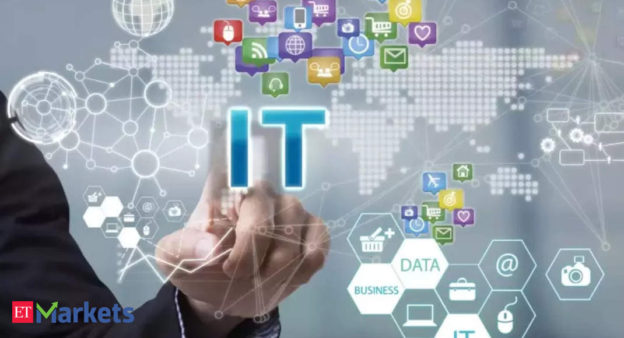Today, digital transformation is fundamentally altering the way all industries do business. With ever changing customer expectations, the need for being more agile, adaptive, and innovative with effective value creation strategies has never been more pressing. The Indian IT industry is certainly poised towards hockey stick growth for the next 5 years.
The Indian IT sector is on a growth trajectory. According to a recent NASSCOM report, despite headwinds in 2020, Indian tech contributed about 8 percent relative share to the national GDP, with 52 percent relative share in services exports, and 50 percent share in total Foreign Direct Investment and growing strong. With the supportive demand environment, most IT services firms are expecting business growth between 5 and 8 percent Q-o-Q in fiscal year 2021.
If we deconstruct the demand, the majority of this growth is coming from digital transformation and modernization initiatives. These initiatives are largely driven by disintermediation in business models, new channel adoption, multi-cloud deployment, decomposable business services and building a zero-trust approach across the ecosystem
Giving a logical construct and categorizing into 5 themes will help services firms to focus:
- Selling Model Shifts – The travelling salesman became extinct during the pandemic. Most selling is now done virtual via digital channels with collaboration platforms as the new medium for day-to-day interactions. Even industries such as medical devices, which in the past largely sold lab equipment through physical meetups, has set up country- specific digital store fronts for selling products. The digital front door combined with Direct to Consumer (DTC) will be the gateway for consumers and businesses or the foreseeable future.
- Move Processing to the Multi-Cloud – During the pandemic, there has beenan uptick in cloud adoption. While most view cloud to be largely a cost saver, there can be no better example than when Stéphane Bancel, Moderna’s CEO, made the decision to build his mRNA research-and-development platform on the public cloud to create what he calls “software for life.” He views the cloud as a means to accelerate therapeutic discovery and development. Cloud will remain as the defacto choice for infrastructure going forward.
- Shift from Products to Platforms –We know the now-canonical early examples of platforms like Amazon, eBay, and Craiglist that have disrupted their respective sectors. Increasingly, we see the rise of micro-vertical marketplaces. Netflix, Salesforce, and Shopify have created a functional niche, and even traditional banks are unbundling their services as Banking-as-a-Service platforms. The largest disruption in the pandemic has been in the payments space. Companies like Paypal, Square, WhatsApp, and Apple Pay have a much larger valuation than traditional payments companies because the ecosystem play is more important than ever yielding exponential valuation.
- “Fort Knox” the Property–The number of cyber threats are on the rise. In the last few years, millions of users’ data has been compromised. This has caused a long lasting and catastrophic effect to both businesses and consumers alike. As a result, currently, security is one of top considerations while designing system, and DevSecOps is core to an engineering build out. The Chief Security Officer is now a key decision maker and is among the top spenders in an enterprise.
- M&A, Unicorns and Effective Value Creation – In the last few years in the enterprise software space, approximately half a trillion dollars have changed hands. Specifically in the PE sector, the deal sizes and valuations are rising owing to intensified competition. With 39 unicorns, India ranks 3rd in the total number of unicorns globally. India added the 2nd highest number of unicorns in 2020 after the US. In both countries, the need for a start-up culture, increasing valuations and at the same time the ability to serve a billion customers is taking the product engineering discipline to newer heights.
Given the above themes, there is a constant need for IT Service providers to up the ante and continue provide value for their customers.
First and foremost, IT services firms need to adopt a “product engineering mindset” with “productized services” towards software development. This brings in disciplined outcomes in a timely manner with Agile at the foundation for execution. Second, delivery of these transformational programs requires tools and accelerators that can capture data as-is through non-invasive means, adding benchmarks and frameworks to modernize through automation. This will aid in reducing cost overall and execution repeatability. Third, most of these programs leverage the current state of the technology stack.
With the rapid changes in technology, it’s important to continuously upskill engineers through rigorous training programs and leveraging a partner ecosystem to bring in the best practices and associated tooling. Fourth, discipline in delivery and pod-based team structures are keys to fostering collaboration and co-engineering delivery models. In this context, it’s important to define measures that matter including business outcomes and a transparent process for reporting. Lastly, as most teams are remote, there is an “empathy deficit” in most organizations. Constant communication with employees and fun at work is more important than ever and key to managing attrition.
Today, digital transformation is fundamentally altering the way all industries do business. With ever changing customer expectations, the need for being more agile, adaptive, and innovative with effective value creation strategies has never been more pressing. The Indian IT industry is certainly poised towards hockey stick growth for the next 5 years.
https://cio.economictimes.indiatimes.com/news/strategy-and-management/demystifying-it-modernization-and-digital-transformation/85582907





